
Who Owns the Moon? – In Defence of Humanity’s Common Interests in Space by A.C. Grayling; Oneworld Publications/distributed by Simon & Schuster (2024); Hardcover, 224 pages; $26.95.
Multiple countries have the Moon within its cross-hairs, for scientific purposes, for industrial gain, as well as to salute its military usefulness. Of late, China has put into action a lunar agenda that includes outreach to the Moon, planting taikonaut footprints there in the time-aged, dusty topside.
Meanwhile, NASA’s Artemis project also aims to “reboot” the Moon in a few years time.
So not only is this book timely reading – it’s a must-read. As the world’s superpowers and corporations jostle for control in space, it asks: who really can claim ownership of that world?
“To answer this question we have to look at some highly relevant precedents,” the author writes, as this is the aim of the volume.
Grayling is the founder and principal of the New College of the Humanities at Northeastern University, London, and its Professor of Philosophy.
Within its pages, the key chapters discuss the global commons, Antarctic protection, the high seas and deep oceans, as well as tackling a major issue of the day: Is the United Nations Outer Space Treaty “good enough” or ripe for an overhaul?
A space spinoff for discussion is addressed in this volume. That is, is there something available to humankind that is more powerful than partisan self-interest, be it profit motive, diplomatic power and national prestige?
The book concludes with a section, “what will happen…what can be done?” Grayling writes that the answer will take maturity, wisdom – “neither of which has evolved to a sufficient degree so far,” but there are some encouraging signs.
The book has a handy bibliography and very healthy section of notes for the reader to pursue.
Grayling makes the case for a new global consensus, one that recognizes the rights of everyone who lives on this planet, but also longingly looks at the Moon and ponders how it fits into our 21st century landscape of posturing politics, resource requirements, and whether the Moon is an extension of human conflict.
For more information on this timely book, go to:
https://www.simonandschuster.com/books/Who-Owns-the-Moon/A-C-Grayling/9780861547258

By RICHARD TRIBOU | rtribou@orlandosentinel.com | Orlando Sentinel
PUBLISHED: May 22, 2024
KENNEDY SPACE CENTER — NASA announced late Tuesday that it was no longer aiming for a Saturday launch of a pair of astronauts aboard Boeing’s CST-100 Starliner as teams discuss a helium leak found on the spacecraft.
While the range was cleared for Sunday and Tuesday backup launch windows, NASA said the next possible launch “is still being discussed.”
At issue has been a helium leak found on Starliner’s propulsion module. NASA previously stated that the leak had undergone pressure tests mimicking what would be endured during launch, and was “stable and would not pose a risk at that level during the flight.”
But discussion about its potential danger continues.
“The team has been in meetings for two consecutive days, assessing flight rationale, system performance, and redundancy. There is still forward work in these areas,” NASA said in an emailed statement. “NASA will share more details once we have a clearer path forward.”
It’s another in a series of delays to get the first crewed launch of the Starliner spacecraft off the ground. NASA’s Butch Wilmore and Suni Williams were strapped in and ready to fly when teams scrubbed an attempt back on May 6 because of a valve issue with United Launch Alliance’s Atlas V upper stage.
The decision was made to roll the rocket back off the pad at Cape Canaveral Space Force Station’s Space Launch Complex 41 to replace the valve. While that work was being done, managers began taking a closer look at a helium leak also discovered on May 6 but not deemed big enough to stop the countdown at the time.
NASA had initially targeted May 17, and then May 21 and then May 25, but now all have been taken off the board.
With it off the pad, and in ULA’s Vertical Integration Facility at SLC-41, a deeper dive has been taken to assess the risk of the leak, which was traced to a flange on one of the reaction control system thrusters within one of the four engine compartments of Starliner’s service module.
If it’s determined work needs to be done on the service module, it could mean returning the Starliner to Boeing’s facilities at KSC for repairs, which would push the launch attempt to later this summer. NASA has not indicated what options are on the table.
Boeing is trying to join SpaceX as one of two providers under NASA’s Commercial Crew Program to provide transportation of astronauts to and from the International Space Station.
SpaceX has been flying its Crew Dragon spacecraft since May 2020 to the ISS while Boeing has had to undergo major software, hardware and management changed to the Starliner program putting Boeing now four years behind.
When it does launch, the Crew Flight Test aims to let Williams and Wilmore test out the spacecraft’s manual flight backup options to what would normally be an automated system that docks with the ISS. They will spend about eight days on board before returning to Earth for a landing in the desert in the western United States.
If all goes well, the first crew rotation mission, Starliner-1, could come as early as February 2025, and be the first of six contracted flights for Boeing through 2030 with one launch a year trading off duties with SpaceX.
For now, SpaceX’s Crew-7 remain on board the ISS awaiting to welcome the Starliner crew, but will be replaced this August when Crew-8 launches from KSC to replace them.
If Starliner’s test flight gets delayed too much, the Crew-9 team could take the February 2025 launch slot.
Euclid space telescope captures stunning new image of the dark universe
Thu, May 23, 2024
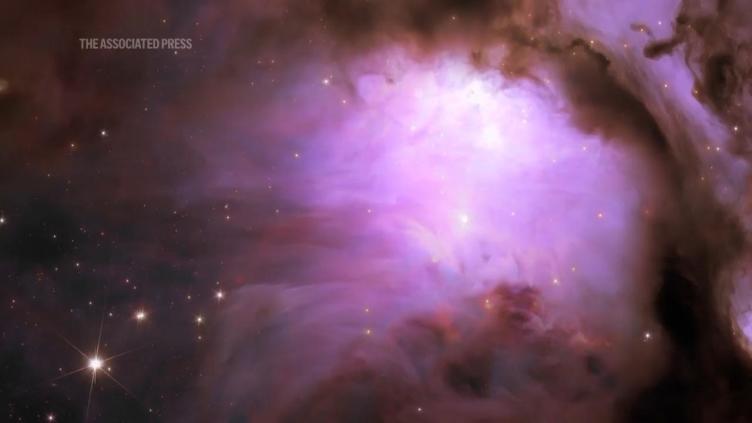
Dazzling stars and swirling galaxies: The European Space Agency (ESA) has released new images taken by the Euclid space telescope, calling the pictures "unprecedented" and a "treasure trove."
Mars' Moon May Not Be What We Think, Scientists Claim
Sharon Adarlo
Fri, May 24, 2024
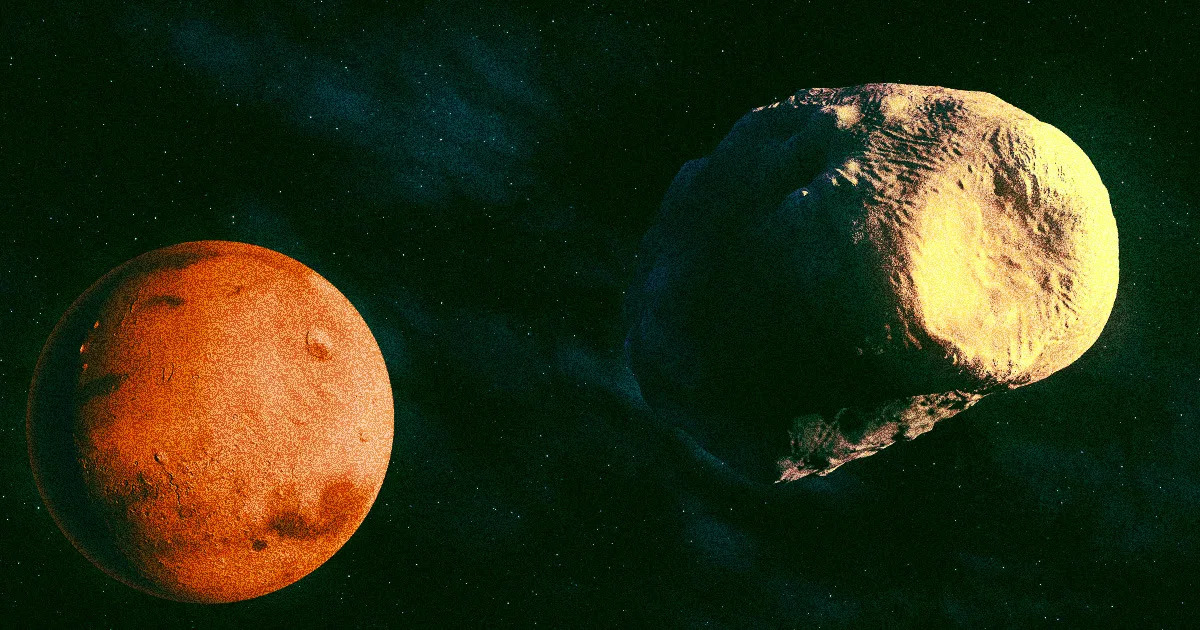
Phobos Anomaly
The conventional wisdom about Mars' small and misshapen moons, Phobos and Deimos, is that they were either created like Earth's Moon — carved out of the planet by an impact with a huge object — or that they were passing asteroids that Mars' gravitational field captured, or perhaps remnants from an earlier and larger moon that broke apart.
But a team of scientists from France and Germany have now proposed that Phobos may have been formed from a comet — and that means Deimos could be from the same celestial body, too.
In their study, a preprint for the journal Astronomy and Astrophysics, the scientists stake their claim on images of Phobos taken between 2004 and 2022 by the Mars Express spacecraft, a joint mission by NASA, the European Space Agency and the Italian Space Agency.
By analyzing details and data from the images, which Live Science lays out in an excellent explainer, the scientists discovered that Phobos has certain properties regarding how it reflects sunlight and its porous sand-like surface that are similar to comets whose orbits are heavily influenced by Jupiter.
From these observations, the scientists suggest that Phobos is actually a comet that Mars' gravitational field captured in the distance past. That could also mean, the scientists reason, that Phobos and Deimos both came from the same comet that was subsequently torn apart.
Moon Detective
In order to find out more about the origins of these moons, Japan is planning on launching sometime this decade the Martian Moons eXploration (MMX) mission, a spacecraft dedicated to studying the two lumpy Martian moons.
First, it will orbit Phobos and perform observational studies of that moon before moving onto Deimos and Mars. Then it will attempt to land on the surface of Phobos and collect samples of the moon for a return trip back to Earth.
Studying these samples will hopefully uncover a rich trove of information such as chemical composition — but perhaps most tantalizingly of all, provide an answer to the mysterious origins of Phobos and Deimos.
More on Mars: Probe Detects "Unknown Features" Inside Martian Moon Phobos
Sunspots and flares could be a product of a shallow magnetic field, according to surprising new findings that may help scientists predict space weather
FULL STORY
The sun's surface is a brilliant display of sunspots and flares driven by the solar magnetic field, which is internally generated through a process called dynamo action. Astrophysicists have assumed that the sun's field is generated deep within the star. But an MIT study finds that the sun's activity may be shaped by a much shallower process.
In a paper appearing in Nature, researchers at MIT, the University of Edinburgh, and elsewhere find that the sun's magnetic field could arise from instabilities within the sun's outermost layers.
The team generated a precise model of the sun's surface and found that when they simulated certain perturbations, or changes in the flow of plasma (ionized gas) within the top 5 to 10 percent of the sun, these surface changes were enough to generate realistic magnetic field patterns, with similar characteristics to what astronomers have observed on the sun. In contrast, their simulations in deeper layers produced less realistic solar activity.
The findings suggest that sunspots and flares could be a product of a shallow magnetic field, rather than a field that originates deeper in the sun, as scientists had largely assumed.
"The features we see when looking at the sun, like the corona that many people saw during the recent solar eclipse, sunspots, and solar flares, are all associated with the sun's magnetic field," says study author Keaton Burns, a research scientist in MIT's Department of Mathematics. "We show that isolated perturbations near the sun's surface, far from the deeper layers, can grow over time to potentially produce the magnetic structures we see."
If the sun's magnetic field does in fact arise from its outermost layers, this might give scientists a better chance at forecasting flares and geomagnetic storms that have the potential to damage satellites and telecommunications systems.
"We know the dynamo acts like a giant clock with many complex interacting parts," says co-author Geoffrey Vasil, a researcher at the University of Edinburgh. "But we don't know many of the pieces or how they fit together. This new idea of how the solar dynamo starts is essential to understanding and predicting it."
The study's co-authors also include Daniel Lecoanet and Kyle Augustson of Northwestern University, Jeffrey Oishi of Bates College, Benjamin Brown and Keith Julien of the University of Colorado at Boulder, and Nicholas Brummell of the University of California at Santa Cruz.
Flow zone
The sun is a white-hot ball of plasma that's boiling on its surface. This boiling region is called the "convection zone," where layers and plumes of plasma roil and flow. The convection zone comprises the top one-third of the sun's radius and stretches about 200,000 kilometers below the surface.
"One of the basic ideas for how to start a dynamo is that you need a region where there's a lot of plasma moving past other plasma, and that shearing motion converts kinetic energy into magnetic energy," Burns explains. "People had thought that the sun's magnetic field is created by the motions at the very bottom of the convection zone."
To pin down exactly where the sun's magnetic field originates, other scientists have used large three-dimensional simulations to try to solve for the flow of plasma throughout the many layers of the sun's interior. "Those simulations require millions of hours on national supercomputing facilities, but what they produce is still nowhere near as turbulent as the actual sun," Burns says.
Rather than simulating the complex flow of plasma throughout the entire body of the sun, Burns and his colleagues wondered whether studying the stability of plasma flow near the surface might be enough to explain the origins of the dynamo process.
To explore this idea, the team first used data from the field of "helioseismology," where scientists use observed vibrations on the sun's surface to determine the average structure and flow of plasma beneath the surface.
"If you take a video of a drum and watch how it vibrates in slow motion, you can work out the drumhead's shape and stiffness from the vibrational modes," Burns says. "Similarly, we can use vibrations that we see on the solar surface to infer the average structure on the inside."
Solar onion
For their new study, the researchers collected models of the sun's structure from helioseismic observations. "These average flows look sort like an onion, with different layers of plasma rotating past each other," Burns explains. "Then we ask: Are there perturbations, or tiny changes in the flow of plasma, that we could superimpose on top of this average structure, that might grow to cause the sun's magnetic field?"
To look for such patterns, the team utilized the Dedalus Project -- a numerical framework that Burns developed that can simulate many types of fluid flows with high precision. The code has been applied to a wide range of problems, from modeling the dynamics inside individual cells, to ocean and atmospheric circulations.
"My collaborators have been thinking about the solar magnetism problem for years, and the capabilities of Dedalus have now reached the point where we could address it," Burns says.
The team developed algorithms that they incorporated into Dedalus to find self-reinforcing changes in the sun's average surface flows. The algorithm discovered new patterns that could grow and result in realistic solar activity. In particular, the team found patterns that match the locations and timescales of sunspots that have been have observed by astronomers since Galileo in 1612.
Sunspots are transient features on the surface of the sun that are thought to be shaped by the sun's magnetic field. These relatively cooler regions appear as dark spots in relation to the rest of the sun's white-hot surface. Astronomers have long observed that sunspots occur in a cyclical pattern, growing and receding every 11 years, and generally gravitating around the equator, rather than near the poles.
In the team's simulations, they found that certain changes in the flow of plasma, within just the top 5 to 10 percent of the sun's surface layers, were enough to generate magnetic structures in the same regions. In contrast, changes in deeper layers produce less realistic solar fields that are concentrated near the poles, rather than near the equator.
The team was motivated to take a closer look at flow patterns near the surface as conditions there resembled the unstable plasma flows in entirely different systems: the accretion disks around black holes. Accretion disks are massive disks of gas and stellar dust that rotate in towards a black hole, driven by the "magnetorotational instability," which generates turbulence in the flow and causes it to fall inward.
Burns and his colleagues suspected that a similar phenomena is at play in the sun, and that the magnetorotational instability in the sun's outermost layers could be the first step in generating the sun's magnetic field.
"I think this result may be controversial," he ventures. "Most of the community has been focused on finding dynamo action deep in the sun. Now we're showing there's a different mechanism that seems to be a better match to observations." Burns says that the team is continuing to study if the new surface field patterns can generate individual sunspots and the full 11-year solar cycle.
This research was supported, in part, by NASA.
Story Source:
Materials provided by Massachusetts Institute of Technology. Original written by Jennifer Chu, MIT News. Note: Content may be edited for style and length.
Journal Reference:Geoffrey M. Vasil, Daniel Lecoanet, Kyle Augustson, Keaton J. Burns, Jeffrey S. Oishi, Benjamin P. Brown, Nicholas Brummell, Keith Julien. The solar dynamo begins near the surface. Nature, 2024; 629 (8013): 769 DOI: 10.1038/s41586-024-07315-1
Massachusetts Institute of Technology. "The origin of the sun's magnetic field could lie close to its surface." ScienceDaily. ScienceDaily, 22 May 2024. <www.sciencedaily.com/releases/2024/05/240522130426.htm>.
Katie Hunt, CNN
Sat, May 25, 2024
I was lucky enough to catch an awesome glimpse of the northern lights from my own home this month when the biggest solar storm to reach Earth in two decades made auroras visible at latitudes much farther south than usual.
Despite living in the light-filled streets of central London, my smartphone camera picked up a green haze and a pulsing sheet of purple and pink light. Capturing the moment was an unforgettable experience and one that I had thought would involve expensive travel to the northernmost reaches of our planet.
The storms that create spectacular auroras such as those I witnessed originate from the sun’s dynamic magnetic field, an astrophysical enigma that scientists this week came closer to unraveling.
Solar update
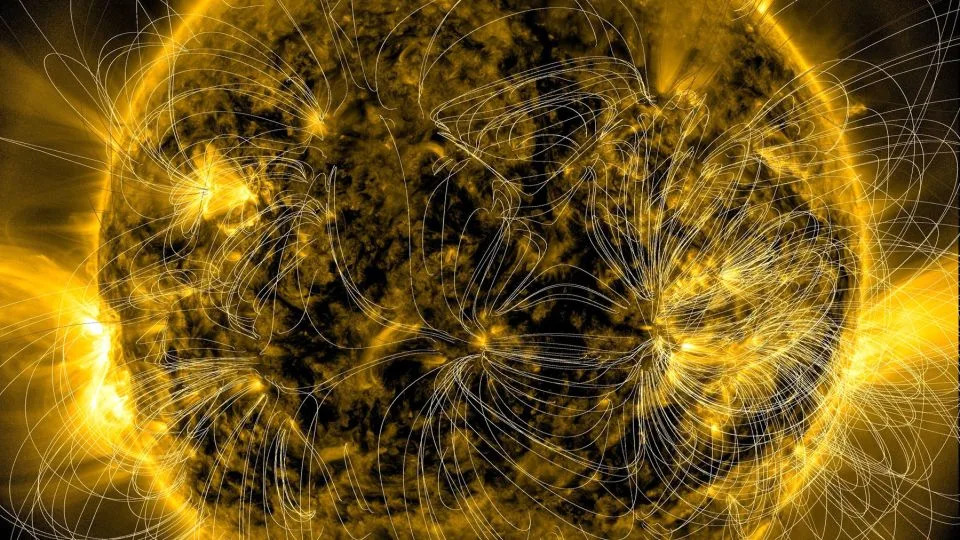
NASA's Solar Dynamics Observatory scientists used computer models to generate a four-day, time-lapse view of the sun's changing magnetic field. The field lines are more concentrated in regions more magnetically intense. - NASA/Solar Dynamics Observatory
Figuring out how the sun’s magnetic field works will help scientists improve the forecasting of space weather, which dazzles night sky watchers but can disrupt GPS and communication satellites.
The sun’s looping magnetic field lines, which form a tangled web of structures more complex than those on Earth, are difficult to study directly. To grasp what’s going on, scientists create mathematical models.
A new model, which took more than a decade to develop and required a NASA supercomputer to conduct the detailed calculations, found that the sun’s magnetic field is generated much closer to the surface than previously thought.
The team believes its model is more accurate because it accounts for a unique solar feature.
A long time ago
A single gold earring found in the ruins of a 2,000-year-old building in the Pyrenees is a clue to how a devastating fire may have started. The inferno consumed the wooden structure, situated in an Iron Age settlement called Tossal de Baltarga, and killed six animals penned in a stable.
Archaeologists believe the fire was deliberate. Had it been accidental, the building’s owners likely would have released the livestock and returned after the fire died down to retrieve their hidden gold, which was concealed in a jar.
The arsonists may have been an invading army under Hannibal, the Carthaginian general who led troops against the Roman Republic, according to the new study.
The fates of the people who used the building are unknown, but the excavation uncovered telling details of the lives of an Iberian people called the Cerretani.
Sky watch
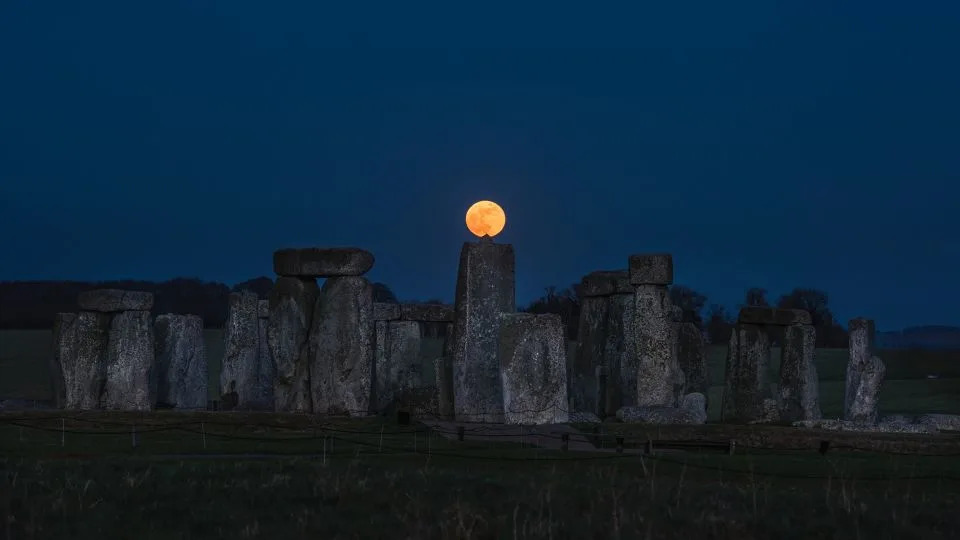
The moon is seen above the megaliths that make up Stonehenge, located on the Salisbury Plain in the county of Wiltshire in England. - Andre Pattenden/English Heritage
The builders of Stonehenge placed the huge stones that make up the prehistoric monument in line with sunrise and sunset on the longest and shortest days of the year, revealing an intimate understanding of the sun that’s still palpable today.
But does the 4,500-year-old site in southwest England — and potentially other megalithic monuments around the world — also align with the moon?
The idea that Stonehenge has a lunar link first gained ground in the 1960s. However, the concept hadn’t been systematically explored — until now.
This summer, archaeologists are using the lunar standstill, a little-known phenomenon that happens every 18.6 years, to investigate.
Across the universe
Space scientists have observed the edge of a black hole — an area known as the “plunging region” — for the first time.
Andrew Mummery, lead author of a new study on black holes and a research fellow at the University of Oxford, compared it to “the edge of a waterfall” at the end of a river, where orbiting material from nearby stars plummets into the abyss.
In the plunging region, matter can no longer stay in orbit and instead hurtles into the black hole. But unlike at the black hole’s event horizon, or surface, light can still escape at this point.
The study’s findings, which Albert Einstein predicted, could help astronomers better understand the formation and evolution of black holes.
Wild kingdom

The Eurasian jay may be capable of a humanlike feat of memory, according to new research. - Philippe Clement/Arterra/Universal Images Group/Getty Images
Corvids — the group of birds that includes crows, ravens and jays — are famously smart. One corvid species may even be capable of something researchers refer to as “mental time travel.”
This type of recollection enables the mind to recall a seemingly unimportant bit of information that you didn’t consciously commit to memory — for instance, remembering what you had for lunch yesterday.
Researchers working with Eurasian jays trained to find food hidden under cups said these birds may be capable of the feat of memory.
In the experiment, which involved decorated cups, the jays were able to remember what a particular cup looked like, even after the cups were rearranged and a time delay.
And in other corvid news, crows can count up to four, the latest research has found.
Explorations
Dive into these mind-expanding stories.
— Thomas Midgley Jr. was a gifted American inventor who made a lasting mark on history. However, his ingenious solutions created even bigger problems.
— Microplastics have been found in human testicles, underscoring the urgent need for more research to understand what role plastics may play in driving infertility.
— An Austrian winemaker has uncovered hundreds of mammoth bones in his cellar, a discovery that one expert labeled an “archaeological sensation.”
Don’t go just yet: NASA has announced the latest on the much delayed Boeing Starliner crewed mission.
Like what you’ve read? Oh, but there’s more. Sign up here to receive in your inbox the next edition of Wonder Theory, brought to you by CNN Space and Science writers Ashley Strickland and Katie Hunt. They find wonder in planets beyond our solar system and discoveries from the ancient world.
The results offer a new way to probe supermassive black holes and their evolution across the universe
FULL STORY
Astronomers at MIT, NASA, and elsewhere have a new way to measure how fast a black hole spins, by using the wobbly aftermath from its stellar feasting.
The method takes advantage of a black hole tidal disruption event -- a blazingly bright moment when a black hole exerts tides on a passing star and rips it to shreds. As the star is disrupted by the black hole's immense tidal forces, half of the star is blown away, while the other half is flung around the black hole, generating an intensely hot accretion disk of rotating stellar material.
The MIT-led team has shown that the wobble of the newly created accretion disk is key to working out the central black hole's inherent spin.
In a study appearing in Nature, the astronomers report that they have measured the spin of a nearby supermassive black hole by tracking the pattern of X-ray flashes that the black hole produced immediately following a tidal disruption event. The team followed the flashes over several months and determined that they were likely a signal of a bright-hot accretion disk that wobbled back and forth as it was pushed and pulled by the black hole's own spin.
By tracking how the disk's wobble changed over time, the scientists could work out how much the disk was being affected by the black hole's spin, and in turn, how fast the black hole itself was spinning. Their analysis showed that the black hole was spinning at less than 25 percent the speed of light -- relatively slow, as black holes go.
The study's lead author, MIT Research Scientist Dheeraj "DJ" Pasham, says the new method could be used to gauge the spins of hundreds of black holes in the local universe in the coming years. If scientists can survey the spins of many nearby black holes, they can start to understand how the gravitational giants evolved over the history of the universe.
"By studying several systems in the coming years with this method, astronomers can estimate the overall distribution of black hole spins and understand the longstanding question of how they evolve over time," says Pasham, who is a member of MIT's Kavli Institute for Astrophysics and Space Research
The study's co-authors include collaborators from a number of institutions, including NASA, Masaryk University in the Czech Republic, the University of Leeds, the University of Syracuse, Tel Aviv University, the Polish Academy of Sciences, and elsewhere.
Shredded heat
Every black hole has an inherent spin that has been shaped by its cosmic encounters over time. If, for instance, a black hole has grown mostly through accretion -- brief instances when some material falls onto the disk, this causes the black hole to spin up to quite high speeds. In contrast, if a black hole grows mostly by merging with other black holes, each merger could slow things down as one black hole's spin meets up against the spin of the other.
As a black hole spins, it drags the surrounding space-time around with it. This drag effect is an example of Lense-Thirring precession, a longstanding theory that describes the ways in which extremely strong gravitational fields, such as those generated by a black hole, can pull on the surrounding space and time. Normally, this effect would not be obvious around black holes, as the massive objects emit no light.
But in recent years, physicists have proposed that, in instances such as during a tidal disruption event, or TDE, scientists might have a chance to track the light from stellar debris as it is dragged around. Then, they might hope to measure the black hole's spin.
In particular, during a TDE, scientists predict that a star may fall onto a black hole from any direction, generating a disk of white-hot, shredded material that could be tilted, or misaligned, with respect to the black hole's spin. (Imagine the accretion disk as a tilted donut that is spinning around a donut hole that has its own, separate spin.) As the disk encounters the black hole's spin, it wobbles as the black hole pulls it into alignment. Eventually, the wobbling subsides as the disk settles into the black hole's spin. Scientists predicted that a TDE's wobbling disk should therefore be a measurable signature of the black hole's spin.
"But the key was to have the right observations," Pasham says. "The only way you can do this is, as soon as a tidal disruption event goes off, you need to get a telescope to look at this object continuously, for a very long time, so you can probe all kinds of timescales, from minutes to months."
A high-cadence catch
For the past five years, Pasham has looked for tidal disruption events that are bright enough, and near enough, to quickly follow up and track for signs of Lense-Thirring precession. In February of 2020, he and his colleagues got lucky, with the detection of AT2020ocn, a bright flash, emanating from a galaxy about a billion light years away, that was initially spotted in the optical band by the Zwicky Transient Facility.
From the optical data, the flash appeared to be the first moments following a TDE. Being both bright and relatively close by, Pasham suspected the TDE might be the ideal candidate to look for signs of disk wobbling, and possibly measure the spin of the black hole at the host galaxy's center. But for that, he would need much more data.
"We needed quick and high-cadence data," Pasham says. "The key was to catch this early on because this precession, or wobble, should only be present early on. Any later, and the disk would not wobble anymore."
The team discovered that NASA's NICER telescope was able to catch the TDE and continuously keep an eye on it over months at a time. NICER -- an abbreviation for Neutron star Interior Composition ExploreR -- is an X-ray telescope on the International Space Station that measures X-ray radiation around black holes and other extreme gravitational objects.
Pasham and his colleagues looked through NICER's observations of AT2020ocn over 200 days following the initial detection of the tidal disruption event. They discovered that the event emitted X-rays that appeared to peak every 15 days, for several cycles, before eventually petering out. They interpreted the peaks as times when the TDE's accretion disk wobbled face-on, emitting X-rays directly toward NICER's telescope, before wobbling away as it continued to emit X-rays (similar to waving a flashlight toward and away from someone every 15 days).
The researchers took this pattern of wobbling and worked it into the original theory for Lense-Thirring precession. Based on estimates of the black hole's mass, and that of the disrupted star, they were able to come up with an estimate for the black hole's spin -- less than 25 percent the speed of light.
Their results mark the first time that scientists have used observations of a wobbling disk following a tidal disruption event to estimate the spin of a black hole. As new telescopes such as the Rubin Observatory come online in the coming years, Pasham foresees more opportunities to pin down black hole spins.
"The spin of a supermassive black hole tells you about the history of that black hole," Pasham says. "Even if a small fraction of those that Rubin captures have this kind of signal, we now have a way to measure the spins of hundreds of TDEs. Then we could make a big statement about how black holes evolve over the age of the universe."
This research was funded, in part, by NASA and the European Space Agency.
Story Source:
Materials provided by Massachusetts Institute of Technology. Original written by Jennifer Chu, MIT News. Note: Content may be edited for style and length.
Journal Reference:Dheeraj R. Pasham, Michal Zajaček, C. J. Nixon, Eric R. Coughlin, Marzena Śniegowska, Agnieszka Janiuk, Bożena Czerny, Thomas Wevers, Muryel Guolo, Yukta Ajay, Michael Loewenstein. Lense–Thirring precession after a supermassive black hole disrupts a star. Nature, 2024; DOI: 10.1038/s41586-024-07433-w
Massachusetts Institute of Technology. "Using wobbling stellar material, astronomers measure the spin of a supermassive black hole for the first time." ScienceDaily. ScienceDaily, 22 May 2024. <www.sciencedaily.com/releases/2024/05/240522130431.htm>.
Scott Sutherland
Fri, May 24, 2024

A 'planet parade' is coming, but you may have the date wrong
There's been a lot of talk on the internet about the so-called "rare planetary alignment" that's supposedly coming up in early June. However, don't believe the hype.
The night sky can put on some spectacular events at times. There are around a dozen meteor showers that send streaks of light over our heads throughout the year. The occasional comet will wow us with its bright tails. A lunar eclipse will turn the Full Moon blood red or a solar eclipse will blot out the Sun. And yes, the planets can sometimes array themselves across the night like a string of bright pearls.
Unfortunately, the odds of being disappointed by these events can sometimes be quite high.
A meteor shower or a comet can be spoiled by the urban light pollution many of us live with on a nightly basis, or even by the light of a Full Moon. An overcast sky can ruin our chances of seeing any of these events, by completely blocking the view.
Or, sometimes, the very technological tools we use to help us get the most out of these night sky events accidentally work against us, by presenting them in a way that raises expectations to unreasonable levels.
Sadly, this appears to be the case with the "June 3rd planetary alignment" that's supposedly coming up.
According to sources on the web, this all started back towards the end of April, with an article written for the planetarium app known as Sky Tonight.
It described an alignment of six planets stretching across the sky on the morning of June 3, 2024.
"In the early morning, six planets — Mercury, Mars, Jupiter, Saturn, Uranus, and Neptune — will align in the sky," the article reads. "Mercury, Mars, Jupiter, and Saturn may be spotted with the naked eye, but you'll need a telescope or high-powered binoculars to see Neptune and Uranus. Let's take a closer look at the conditions for observing the planets."
Indeed, if we use a free planetarium program like Stellarium to view this event, it does look fairly impressive. In addition to those six planets, even the Waning Crescent Moon gets in on the show!
June 3 Alignment - No Atmo
A simulated view of the sky at 5:15 a.m. EDT, on June 3, 2024, from southwestern Ontario, shows six planets lined up along with a thin Waning Crescent Moon. To make the alignment stand out better, the planets are presented as 150 times their normal size, the Moon is shown at 4 times its normal size, and the background stars have been dimmed. (Stellarium/Scott Sutherland)
However, in addition to all of the adjustments made to the above view to make the planetary alignment stand out, there's also one crucial feature missing from it.
To better represent what the sky will really look like at that time, the simulation needs to also account for the effects of Earth's atmosphere.
This view of the sky shows the exact same scene as the previous image, from the same location and at the exact same date and time, however the celestial objects have been returned to their normal size and the effects of Earth's atmosphere have been added back into the simulation. (Stellarium)
The problem with all of the hype about this 'planet parade' is that the timing of the event will make it impossible for us to actually see all of it.
While Saturn, Neptune, and Mars rise before morning twilight, from our perspective here on Earth, Mercury, Jupiter, and Uranus are very close to the Sun right now. Thus, by the time all six planets have crested the horizon, the entire sky will be lit up by the rising Sun.
So, despite all the hype about seeing a 'six-planet parade' in the sky, sadly, it won't be visible to us — at least not on 3rd of June. More on that, below.
What will we see on June 3?
The Sun may be spoiling our view of the full planet parade on June 3, but for those of us with clear skies, we may be able to see part of it.
If you are up very early on that day, before morning twilight begins, Mars, the Moon, and Saturn will be together in the eastern sky. Neptune will also be there, but will not be visible to the unaided eye. A telescope or pair of binoculars will be needed to see it.
Saturn rises around 2:20 a.m., the Moon follows at around 3:10 a.m., and Mars crests the horizon around 3:30 a.m., local time.
The part of the June 3 planet alignment that will actually be visible in the predawn sky is shown in this simulation, with reveals the predawn eastern sky at 4:20 a.m. local time. (Stellarium/Scott Sutherland)
If June 3 doesn't work for you, these same objects will be together in the eastern predawn sky from around May 28 through June 5, with the Moon starting off to the west of Saturn and tracking past the planets throughout that week.
DON'T MISS: Take a mind-bending plunge into a supermassive black hole
The real 'planet parade' is still to come
If you really want to see multiple planets lining up in a 'parade', keep your eyes on the eastern pre-dawn sky as the month of June progresses. However, be sure to watch before twilight begins, as that will make it easier to see.
On the 1st and 2nd of the month, the Waning Crescent Moon will be situated between Mars and Saturn, just above the eastern horizon. Then, on the 3rd and 4th, it will have shifted over to the other side of Mars. For those with binoculars or a telescope, Neptune will be found between Mars and Saturn on all four of these nights, while Uranus will be just in the process of rising (but may be masked by the beginning of twilight).
These four planets will rise earlier and earlier throughout June, thus putting them higher in the sky when dawn approaches.
Mark June 15 on your calendar, because that will probably be the best morning to catch five planets in alignment, as Jupiter joins the others early enough to not get lost in the light of dawn.
Jupiter, Uranus, Mars, Neptune, and Saturn are shown here in alignment at around 4:40 a.m. EDT on June 15, 2024, from southwestern Ontario. (Stellarium/Scott Sutherland)
Those five planets will remain visible in the night sky for the rest of the summer, rising earlier and earlier throughout the season. (Remember that Uranus and Neptune will not be visible to the unaided eye.)
Starting on the morning of June 27, all five will be well above the horizon before morning twilight starts, just in time for the Moon to join the show once again. The Waning Gibbous Moon will be hanging out near Saturn on the 27th, the Last Quarter Moon will nearly block Neptune from view on the 28th (and will completely occult the planet when viewed from farther south), and then the Waning Crescent Moon will drop into alignment with the others on the 29th.
Five planets align with the Waning Crescent Moon at 4:40 a.m. on June 29, 2024. (Stellarium/Scott Sutherland)
If you keep watch on these worlds throughout the summer, you can see them change up their order in the sky as their orbits cause them to pass each other from our point of view here on Earth.
Watch for Mars and Uranus to switch places in the order around mid-July, with Mars and Jupiter slipping by each other to change things up again in mid-August.
Planetarium apps
It was mentioned, above, that the technological tools we use to help us visualize night sky events can sometimes work against us.
As the images used in this article demonstrate, these apps can present views of the sky that don't match up with reality. Some don't even have an option for factoring in whether it's day or night at your location. They simply show the position of the Sun, planets, constellations, stars, and galaxies, as they appear around Earth, at that time.
This is not to say that astronomy and planetarium apps are a bad thing, though. On the contrary, they are invaluable tools for skywatchers and stargazers of all levels of expertise and enthusiasm.
This idealized view presents the sky without the effects of Earth's atmosphere, with the planets at 1000 times their normal size in our sky, the Moon at 4 times its normal size, and with all of the stars removed. This not only emphasizes the alignment, but also demonstrates how, although these programs are quite valuable for the information they can relay, they can also present views of our sky that greatly differ from reality. (Stellarium/Scott Sutherland)
However, when we use these apps, it's up to us to be mindful of what they are showing us.
Does the app allow you to enter your location, so it can take into consideration whether it's day or night when a celestial event is occurring? Is the app presenting the Moon and planets as they would actually appear, or does it show them as oversized, idealized versions to make them stand out against the background?
Knowing the answers to these questions, or picking an app that simulates the sky as close to reality as possible, can help prevent disappointment.
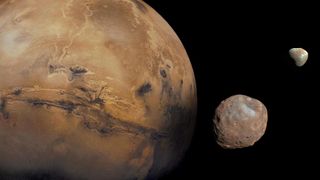
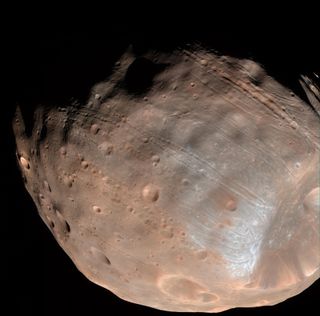


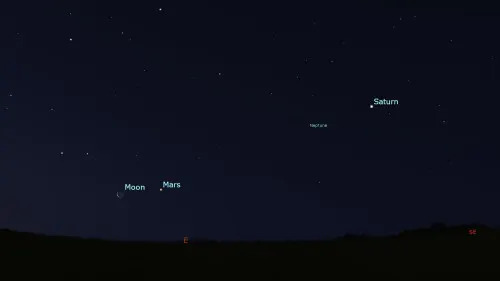
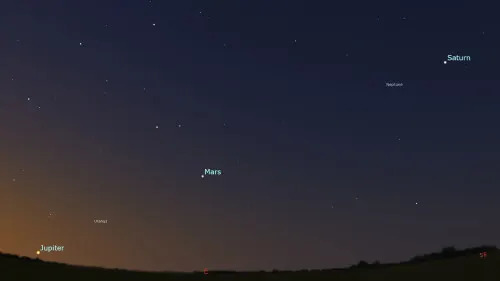

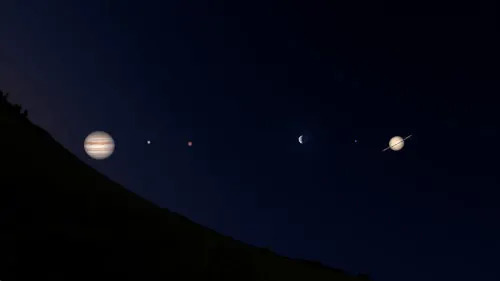
No comments:
Post a Comment